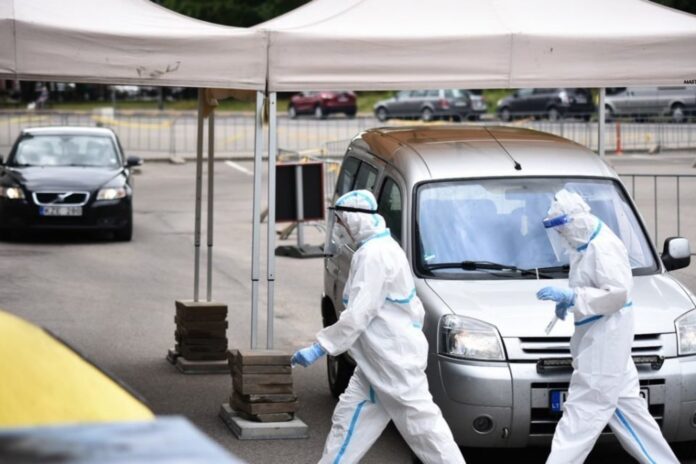
COVID-19 Update
On September 17, there were 61 new COVID-19 cases detected in Lithuania, adding to 3565 confirmed cases in the country. Since June 1, a total of 238 imported coronavirus cases were confirmed. On September 18, Health Minister Aurelijus Veryga announced that clients in bars, restaurants, and cafes will no longer be required to wear facemasks while waiting for their order. People will still be required to wear them when entering a catering establishment. Under the previous rules, clients had to wait for their order wearing a mask.
By Monday, September 21, seventy new coronavirus cases were reported. Six of them are patients at a hospital in Radviliškis, a town in northern Lithuania. The hotspot currently accounts for 63 infections, including 35 hospital patients and 26 staff members. In response to the rapidly spreading infection, Radviliškis municipality announced on Saturday that all schools except primary would be switching to remote teaching and all public events would be cancelled.
Eight cases in Vilnius have been linked to the dance studio City Dance. Another hotspot in the city is a gym (Gym Plius) which currently accounts for 12 cases of Covid-19. One new case is an employee at a spa in central Vilnius (SPA Vilnius). The person had direct contact with some of clients who are being traced, according to the National Public Health Centre (NVSC). One more case is a student at Gabija Progymnasium in Vilnius, another hotspot of the virus. Currently, the school accounts for 22 confirmed coronavirus cases.
The coronavirus continues to spread among students. As of September 21, 61 students and 15 teachers have been diagnosed with Covid-19, the Education Ministry reported. As many as 1,136 people are in self-isolation due to infections in school communities. In all, Lithuania has 3,814 confirmed cases of Covid-19. At the moment, 1,511 are considered active cases, while 2,199 people have recovered.
Eighty-seven people have died from the coronavirus in the country so far. Seventeen more people who had the disease died of other causes, including three reported on September 19.
Currently, 13,927 people are in isolation. The number includes active cases, their close contacts and travellers from coronavirus-affected countries who are subject to the self-quarantine requirement.
Lithuania has been added to Latvia’s blacklist of coronavirus-affected countries. Travellers from Lithuania are now required to go into 10-day self-isolation when they go to the neighbouring country. Latvia’s Centre for Disease Prevention and Control announced the rule on September 18. The self-isolation requirement applies to all countries with infection rates of more than 16 new cases per 100,000 people over the last two weeks. Lithuania’s rate stood at 18.8 on Friday, according to the European Centre for Disease Prevention and Control, while Latvia’s was 4.4, one of the lowest in Europe. Estonian travellers have been required to self-isolate in Latvia since September 12. Lithuania recently raised the infection threshold from 16 to 25 cases per 100,000 people.
Lithuania’s Health Ministry has published an updated list of coronavirus-affected countries.
As of September 21, travellers arriving in Lithuania from Bulgaria, Sweden, Norway, Georgia, Canada, Tunisia, and the Faroe Islands will also be required to self-isolate. In all, arrivals from 20 EU countries are now required to provide a prior Covid-19 test and to self-isolate for two weeks once in the country. Under the current rules, non-residents coming to Lithuania from the affected countries need to have a negative Covid-19 test taken no earlier than 72 hours before departure, and to self-isolate for two weeks upon arrival. Lithuanian residents and nationals only need to take a Covid-19 test within three days after arriving in the country. Although Estonia has reached more than 25 cases of Covid-19 per 100,000 people, the Baltic country has not been added to the list.
People who need to leave the country before the end of the self-isolation period must inform Lithuanian authorities no later than a day before departure. People coming to Lithuania are required to fill out an electronic form and present the QR code before boarding their plane, bus, or ferry. Those coming by private transport need to register with the National Public Health Centre within 12 hours or arrival. The self-isolation period can be shortened by taking a coronavirus test on the eighth day of isolation. Upon receipt of a negative result, the period can be cut down to 10 days.
Belarusians Granted Entry
Lithuania has granted permission to 262 Belarusian nationals to come to the country on humanitarian grounds, according to the Interior Ministry. So far, 69 of them have arrived in the country. Another 18 people from Belarus have applied for asylum in Lithuania. While travel from Belarus to Lithuania is restricted due to the coronavirus, Belarusians can seek entry “on special humanitarian grounds” since mid-August, after the Belarusian government unleashed a brutal crackdown on peaceful protesters. Svetlana Tikhanovskaya, the leading opposition candidate, arrived in Lithuania immediately after the presidential election.
Belarusian nationals seeking to come to Lithuania on humanitarian grounds have to apply at the Lithuanian embassy for a Schengen visa and provide necessary information.
Who‘s Who in the Parliamentary Election
Lithuanian Radio and Television (LRT.lt) News in English presented an overview, summarized here, of the main parties and their platforms for the parliamentary elections on October 11.
Three parties have been consistently leading in the surveys, but some old and some newly-founded groups have entered the race and voters will be anxious to see who will cross the 5% electoral threshold.
Homeland Union-Lithuanian Christian Democrats (TS-LKD)
Poll rating: 15.3% (Spinter Tyrimai); 14.9% (Vilmorus); 13.8% (Baltijos Tyrimai)
With two terms in the opposition, Lithuania’s main centre-right party (the conservatives) is leading in the polls and expects to emerge the winner, yet there is no guarantee that it will be able to form the ruling coalition. The TS-LKD platform focuses on reforming education and healthcare and transforming the economy with a moderate focus on market-led green growth. Under its young leader Gabrielius Landsbergis, the party has a younger face, with lead candidate, former finance minister Ingrida Šimonytė, who would likely be prime minister if the conservatives win. Their modern image is encumbered by the party’s prominent right wing that prefers socially conservative and somewhat nationalistic policies.
The Lithuanian Farmers and Greens Union (LVŽS)
Poll rating: 13.7% (Spinter Tyrimai); 15.1% (Vilmorus); 14.3% (Baltijos Tyrimai)
Dominating the ruling coalition since 2016, the farmers claim that their accomplishments speak for themselves and their main promise is to continue their policies. Blessed with a term during an economic upturn, they take credit for rising wages, pensions and welfare benefits, as well as managing the coronavirus pandemic well. While presenting themselves as a centre-left party, promising to fight poverty and reduce the gap between the capital city and the provinces, the farmers have also taken pains to emphasize their business-friendly credentials. One of its legacies has been a tax cut that some say aggravated the underfunding of the country’s public services. The party’s lead candidate and potential prime minister is the incumbent Saulius Skvernelis, even though the puppet master is its leader, socially conservative agro-millionaire Ramūnas Karbauskis. The party’s election slogan is “For You. For Family. For Lithuania”.
The Social Democratic Party (LSDP)
Poll rating: 8.9% (Spinter Tyrimai); 8.5% (Vilmorus); 13.3% (Baltijos Tyrimai)
The country’s main centre-left party led the 2012-2016 government and started off as the LVŽS’ junior partner after the 2016 elections. However, the following year, LSDP’s new leader Gintautas Paluckas decided to quit the ruling coalition, precipitating a split in the party. Some of its old guard, including a former prime minister, founded a new party with a very similar name – the Social Democratic Labour Party (LSDDP) – which remained in government. Since then, the social democrats maintained a low profile in the opposition, achieving average results in local and presidential elections. Heading into October 2020, Paluckas boasts of a “balanced” platform which, he says, focuses as much on taxes as on government spending. The LSDP calls for cutting consumption levies and raising taxes on wealth and profits. While Paluckas leads the party’s list and is its PM candidate, he has yet to prove his leadership credentials – his campaign for the mayorship of Vilnius last year ended in abject failure, as did his bid to win a parliament seat in last year’s by-elections.
Labour Party
Poll rating: 6.1% (Spinter Tyrimai); 8.4% (Vilmorus); 8.3% (Baltijos Tyrimai)
Once a prominent force in Lithuanian party politics, the Labour Party has been left out of parliament and was relatively invisible over the last four years, so its good performance in recent polling comes as somewhat of a surprise. The party owes its success and existence entirely to the wealth and charisma of its founder Viktor Uspaskich who used populistic tactics long before they trended in Western Europe and the US. Railing against “traditional parties” and promising to care for the common man, Uspakich has also been embroiled in numerous corruption investigations. This time, its platform promises to improve business conditions for local producers and boost private investment in the country’s regions. Uspaskich himself is not running for a parliamentary seat, preferring to keep his mandate in the European Parliament, but said that he would return to Vilnius if he were offered the premiership or an economy-related post in the cabinet.
Freedom Party
Poll rating: 4.8% (Spinter Tyrimai); 2.5% (Vilmorus); 2.9% (Baltijos Tyrimai)
Founded last year, the Freedom Party consists mostly of liberals who were formerly in the Liberal Movement, but followed Vilnius Mayor Remigijus Šimašius when he left the party.
Focusing on young urban middle classes – a limited, if growing constituency in Lithuania – the Freedom Party’s platform promises to legalize same-sex marriage, recreational marijuana and embraces transgender rights. At the same time, it is advocating hardcore pro-business policies: cutting taxes, reducing regulation, relaxing the labour code. The party says its goal would be to put Lithuania at the top of the World Bank’s Doing Business ranking. While not seriously expecting to win the majority, party leader Aušrinė Armonaitė says the goal is to get at least 100,000 votes.
The Liberal Movement
Poll rating: 4.2% (Spinter Tyrimai); 5.5% (Vilmorus); 6% (Baltijos Tyrimai)
The Liberal Movement, once Lithuania’s most prominent liberal force, is still recovering from the 2016 corruption scandal that has its former leader Eligijus Masiulis fighting bribery charges in courts. Under the leadership of MP Viktorija Čmilytė-Nielsen, the party is proposing a pro-business and anti-regulation platform, in opposition to the current government’s policies.
Freedom and Justice
Poll rating: 3.2% (Spinter Tyrimai); 3.8% (Vilmorus); 5.4% (Baltijos Tyrimai)
Founded last June, Freedom and Justice is an amalgamation of three older groups: the Lithuanian Freedom Union of former Vilnius mayor Artūras Zuokas, the Forward Lithuania movement of former Seimas speaker Artūras Paulauskas and the Order and Justice party led by Remigijus Žemaitaitis. The trio have been dubbed “the three musketeers” and are running with the slogan “One for all, all for Lithuania”. Among the party’s more original proposals is to extend the parliamentary term from four to five years and set up the Ministry of Future – in charge of the knowledge economy, scientific and technological innovation, and other buzzwords of the day. Freedom and Justice says it is targeting centre-right voters with a mixture of pro-business policies and somewhat socially liberal proposals.
The Electoral Action of Poles in Lithuania-Christian Families Alliance (LLRA-KŠS)
Poll rating: 3.2% (Spinter Tyrimai); 2.5% (Vilmorus); 2.9% (Baltijos Tyrimai)
The party’s base is Lithuania’s Polish-speaking minority, mostly concentrated in the southeastern districts of the country, and as such it has always enjoyed a small but stable support. It takes part in the current ruling coalition with two ministers in the cabinet.
Led by MEP Valdemar Tomaševski, the LLRA is one of the most socially conservative parties in the country that once advocated a ban on abortion. It prefaces its platform manifesto with a quote from St Augustine and concludes it with “so help us God”. In addition to promises to advance Christian and traditional family values, the LLRA-KŠS calls for publishing the lists of Lithuania’s former KGB collaborators and devolving more power to local authorities – which makes sense for a party with a very localised constituency. At the same time, the party promises to increase welfare benefits and cut income tax on minimum wage earners to near-zero, with a harsh tax on bank assets and supermarket turnover.
The Social Democratic Labour Party (LSDDP)
Poll rating: 2.6% (Spinter Tyrimai); 3% (Vilmorus); 2% (Baltijos Tyrimai)
Founded in 2018, the LSDDP is a result of the split in the Social Democratic Party that happened after a newly-elected leader decided to pull the party out of the ruling coalition. Reluctant to leave power, a group of prominent social-democratic members quit the party to form a new one with a near-identical name. With former prime minister, Gediminas Kirkilas, and a current foreign minister, Linas Linkevičius, on its candidate list, the LSDDP presents itself as a party of expertise and experience. Its platform extolls classical social-democratic principles – social security and public services – while taking pains not to alienate businesses with talk of new taxes to pay for them.
News from LRT.lt





























